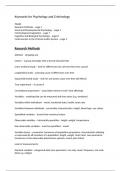Keywords for Psychology and Criminology
PAGES
Research Methods – page 1
Social and Developmental Psychology – page 3
Criminological Imagination – page 7
Cognitive and Biological Psychology – page 8
Controversies in the Criminal Justice System – page 9
Research Methods
Attrition – dropping out
Cohort – a group of people with a shared characteristic
Cross-sectional study – look for differences but not how they were caused
Longitudinal study - assessing cause of differences over time
Sequential/mixed study – look for and assess cause over time (all effects)
True experiment – A causes B
Correlational experiment – association esteem X and Y (not affecting)
Variables – anything that can be measured and that varies (e.g. emotions)
Variables within individuals – mood, emotional state, health, heart rate
Variables between individuals – personality characteristics, height, blood type, eye colour
Quantified variables – turned into numerical values
Observable variables – intrinsically quantities - height, weight, temperature
Non observable variables – must be quantified – mood
Variable classes – parametric (measures of population parameters; characteristics defining
or expressed by all members of a population; height, weight, heart rate), non-parametric
(measures of non observable phenomena; opinion, mood, pain states)
Level of measurements:
Nominal variables - categorical data (non-parametric; can only count, frequency, not scale
data) e.g. religion
, Ordinal variables - ranked data, variable intervals (NP; scale data with variable intervals,
limitations on comparisons) e.g. level of stress
Interval variables - direct measure, identical intervals , no fixed zero (parametric; scale data
suitable for comparison but cannot calculate ratios) e.g. temperature Celsius and Fahrenheit
Ratio variables - direct measure, identical intervals, fixed zero (P; scale data suitable for
comparison and ratios) e.g. absolute absence of heart rate, no minus in weight
Mode – most frequent value in a set of categorical (nominal) data
Median – middle value of a series of ranked scores
Range – lowest score subtracted from the highest score
Mean – recuse arithmetic centre of all values in a set
Standard deviation – measure of the degree to which the data are spread around the mean
Asymptote – a line or curve that acts as the limit of another line or curve
Beta – probability of type 2 error
Alpha – probability of type 1 error
Probability sampling method - selected at random in target population, accurate sample -
simple random, cluster random (random selection of clusters and then random selection of
individuals within), systematic (individuals selected according to random starting point but
within a fixed interval, e.,g. Every 3rd person), stratified random (pop divided into strata like
sex or education and individuals are randomly selected from within strata)
Non-probability sampling method – based on subjective judgement of researcher, useful
when target population has similar traits; sampling bias – convenience (non-random
selection accessible to researcher), judgmental/purposive (selection based on specific
characteristic), snowball (initial participant asked to identify unthreatening participants from
their social group like family or friends), quota (selection of fixed number of participants
from groups with predetermined characteristic like sex, age, ethnicity)
Theory – an explanation for some observable phenomenon – they generate hypotheses
Hypothesis – a positive, definitive prediction stemming from observing or generated by a
theory – allows elements of the theory to be tested – statements that the researcher must
try to prove wrong
Law – simple description of what will happen when certain conditions are met.




